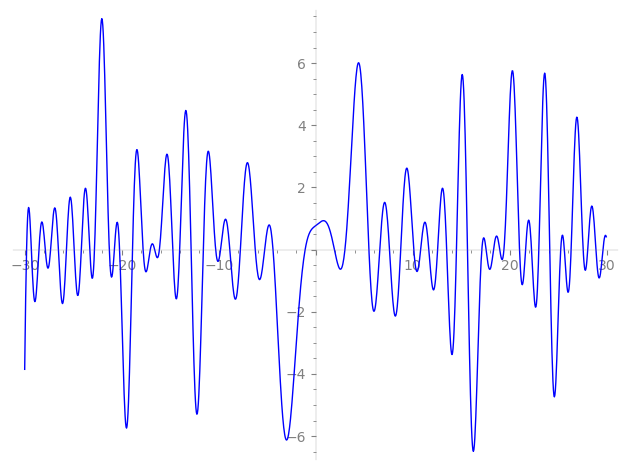| L(s) = 1 | + (−0.982 + 1.01i)2-s + (−0.987 + 1.42i)3-s + (−0.0680 − 1.99i)4-s + (1.77 − 3.07i)5-s + (−0.476 − 2.40i)6-s + (0.793 − 2.52i)7-s + (2.09 + 1.89i)8-s + (−1.04 − 2.81i)9-s + (1.38 + 4.83i)10-s + (−0.396 + 0.229i)11-s + (2.91 + 1.87i)12-s + 0.799i·13-s + (1.78 + 3.28i)14-s + (2.62 + 5.57i)15-s + (−3.99 + 0.271i)16-s + (5.48 − 3.16i)17-s + ⋯ |
| L(s) = 1 | + (−0.694 + 0.719i)2-s + (−0.570 + 0.821i)3-s + (−0.0340 − 0.999i)4-s + (0.795 − 1.37i)5-s + (−0.194 − 0.980i)6-s + (0.299 − 0.953i)7-s + (0.742 + 0.670i)8-s + (−0.349 − 0.936i)9-s + (0.437 + 1.52i)10-s + (−0.119 + 0.0690i)11-s + (0.840 + 0.541i)12-s + 0.221i·13-s + (0.477 + 0.878i)14-s + (0.678 + 1.43i)15-s + (−0.997 + 0.0679i)16-s + (1.33 − 0.767i)17-s + ⋯ |
\[\begin{aligned}\Lambda(s)=\mathstrut & 168 ^{s/2} \, \Gamma_{\C}(s) \, L(s)\cr =\mathstrut & (0.999 + 0.0114i)\, \overline{\Lambda}(2-s) \end{aligned}\]
\[\begin{aligned}\Lambda(s)=\mathstrut & 168 ^{s/2} \, \Gamma_{\C}(s+1/2) \, L(s)\cr =\mathstrut & (0.999 + 0.0114i)\, \overline{\Lambda}(1-s) \end{aligned}\]
Particular Values
| \(L(1)\) |
\(\approx\) |
\(0.772137 - 0.00442539i\) |
| \(L(\frac12)\) |
\(\approx\) |
\(0.772137 - 0.00442539i\) |
| \(L(\frac{3}{2})\) |
|
not available |
| \(L(1)\) |
|
not available |
\(L(s) = \displaystyle \prod_{p} F_p(p^{-s})^{-1} \)
| $p$ | $F_p(T)$ |
|---|
| bad | 2 | \( 1 + (0.982 - 1.01i)T \) |
| 3 | \( 1 + (0.987 - 1.42i)T \) |
| 7 | \( 1 + (-0.793 + 2.52i)T \) |
| good | 5 | \( 1 + (-1.77 + 3.07i)T + (-2.5 - 4.33i)T^{2} \) |
| 11 | \( 1 + (0.396 - 0.229i)T + (5.5 - 9.52i)T^{2} \) |
| 13 | \( 1 - 0.799iT - 13T^{2} \) |
| 17 | \( 1 + (-5.48 + 3.16i)T + (8.5 - 14.7i)T^{2} \) |
| 19 | \( 1 + (2.61 - 4.53i)T + (-9.5 - 16.4i)T^{2} \) |
| 23 | \( 1 + (-1.55 + 2.68i)T + (-11.5 - 19.9i)T^{2} \) |
| 29 | \( 1 + 2.60T + 29T^{2} \) |
| 31 | \( 1 + (-4.42 + 2.55i)T + (15.5 - 26.8i)T^{2} \) |
| 37 | \( 1 + (2.89 + 1.67i)T + (18.5 + 32.0i)T^{2} \) |
| 41 | \( 1 - 10.1iT - 41T^{2} \) |
| 43 | \( 1 - 3.56T + 43T^{2} \) |
| 47 | \( 1 + (2.15 - 3.73i)T + (-23.5 - 40.7i)T^{2} \) |
| 53 | \( 1 + (-1.16 - 2.02i)T + (-26.5 + 45.8i)T^{2} \) |
| 59 | \( 1 + (1.49 - 0.864i)T + (29.5 - 51.0i)T^{2} \) |
| 61 | \( 1 + (-4.60 - 2.66i)T + (30.5 + 52.8i)T^{2} \) |
| 67 | \( 1 + (-0.00979 - 0.0169i)T + (-33.5 + 58.0i)T^{2} \) |
| 71 | \( 1 + 9.04T + 71T^{2} \) |
| 73 | \( 1 + (-4.15 - 7.19i)T + (-36.5 + 63.2i)T^{2} \) |
| 79 | \( 1 + (10.8 + 6.28i)T + (39.5 + 68.4i)T^{2} \) |
| 83 | \( 1 - 0.694iT - 83T^{2} \) |
| 89 | \( 1 + (-7.02 - 4.05i)T + (44.5 + 77.0i)T^{2} \) |
| 97 | \( 1 - 7.05T + 97T^{2} \) |
| show more | |
| show less | |
\(L(s) = \displaystyle\prod_p \ \prod_{j=1}^{2} (1 - \alpha_{j,p}\, p^{-s})^{-1}\)
Imaginary part of the first few zeros on the critical line
−12.84470007806998910987663742892, −11.59194104243450857512564265189, −10.31211288107932690321670809839, −9.809134476371044028786496383516, −8.856909037709107639249469611993, −7.76758963970938187009544135030, −6.23339438475832082105932705333, −5.26397591698371328829243171134, −4.40296521138567192703956817661, −1.09058290625794011426296884400,
1.92709563877778171617926670832, 3.00930964797720064163324419513, 5.48284928235432705841155200946, 6.59873794018834260508015337385, 7.60548967799814840400790568304, 8.760219697270913078864284926170, 10.10652364406191742007846537214, 10.81594317554563917924559636465, 11.65764502781934823287100843949, 12.56353618694170397673143502528

